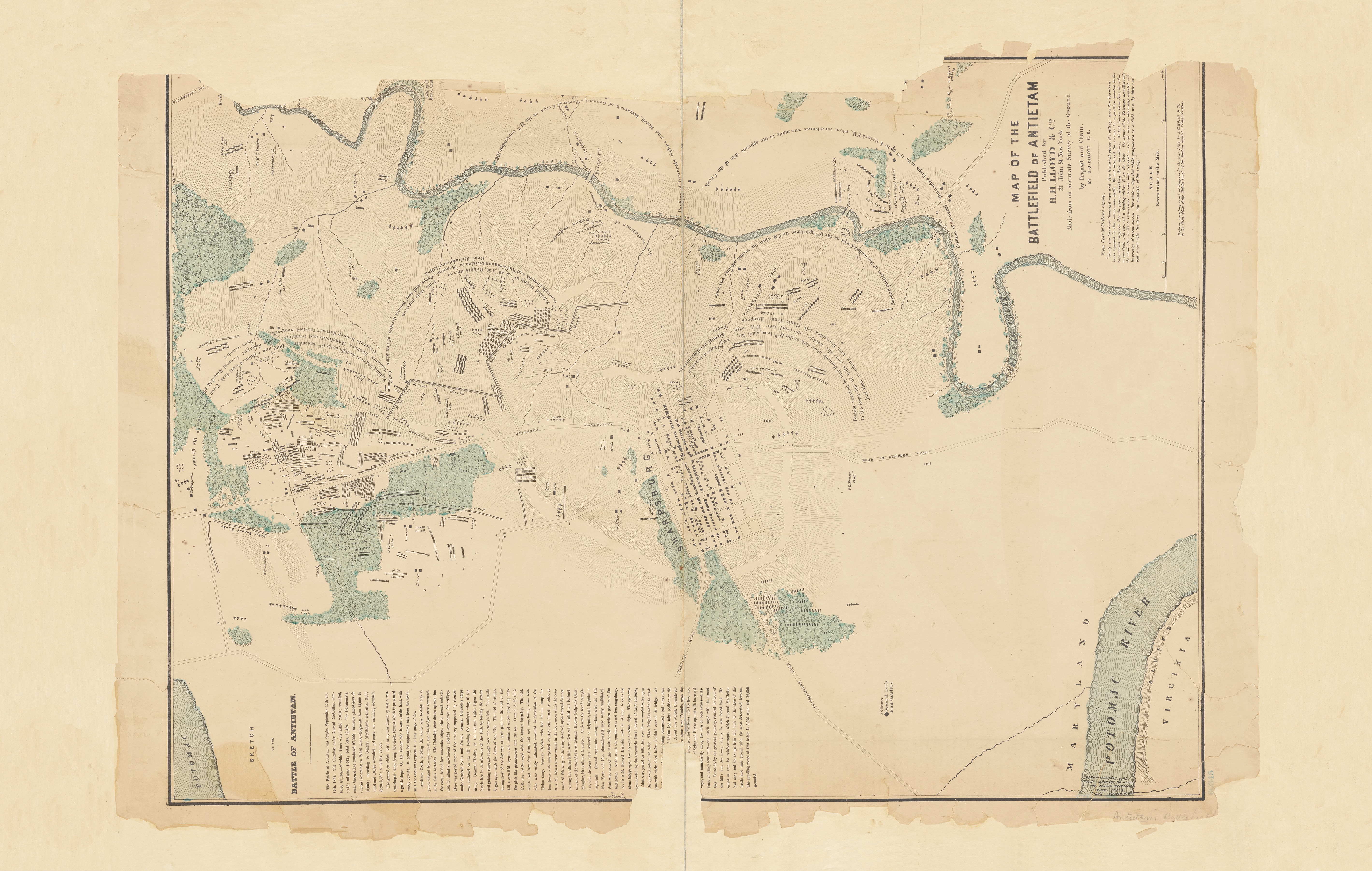New revelations from a recently discovered map.
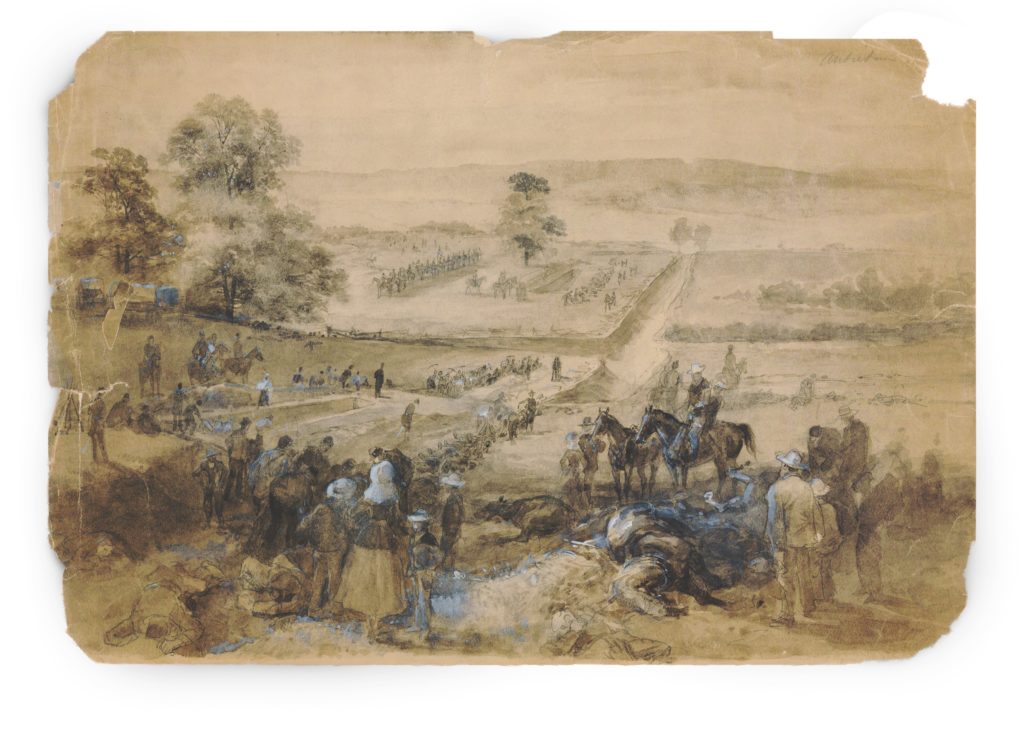
Nightfall on September 17, 1862
brought to a close the Battle of Antietam, ending America’s bloodiest single day. While this notorious title is not in doubt—it has remained so through wars, natural disasters, and even modern America’s horrific 2001 terrorist attacks—uncertainty still exists regarding the day’s exact death toll. A recently discovered map, however, is helping change that. Sunrise on September 18 brought many tasks to those who had survived Antietam’s firestorm. Generals George B. McClellan and Robert E. Lee faced deciding their two armies’ next steps. Officers of Federal and Confederate units large and small struggled to collect and re-form their commands for whatever those two commanders decided. Surgeons on both sides of Antietam Creek struggled to save lives of the wounded survivors, while the men in their care carried on a new fight to simply survive another day. Many of those in blue and gray who escaped unharmed returned to their mundane roles of guard duty, cooking, cleaning weapons, or similar routine tasks. Others, however, found themselves assigned the unpleasant task of burying the dead who littered the once-peaceful fields of Sharpsburg, Md. Despite having helped repulse Brig. Gen. Howell Cobb’s Brigade’s assault on the Sunken Road the day before, the 64th New York’s Ephraim Brown recorded that he and two comrades early on September 18 were “detailed to look for Our Dead. We took Ephraim Green…off under flag of truce & the Sharp Shooters whizzed 5 bullets at us…we then got Norman Foster[,] William Fuller & John Orr & carried them back down the slope to a house & barn & buried them under a big apple tree…taking a good pine board from the barn & marking E. Green inscription & putting it to his head.” Tough as they were to perform, these acts of kindness for fallen friends paled in comparison to their duty the following day. When Lee’s Army of Northern Virginia slipped away to reenter Virginia, dawn on September 19 revealed that only Confederate dead remained. Private Brown found that “today I was given detaile to burry the Dead Rebels…12 lengths of fence being counted off for my own station & in 10 rods we have piled & buried 264.”
Ever since Ephraim Brown recorded this number, tallying the Battle of Antietam’s bloody cost has held a morbid fascination for historians and the public alike. That such counts revealed Antietam as America’s deadliest day became clear within weeks of the battle itself, if not long since to those such as Private Brown who were charged with burying the dead. Even so, reaching an exact count of the lives lost in the short, sharp contest around Sharpsburg has remained elusive.
Explanations for this enduring uncertainty extend to the war itself. Neither army required reporting specific casualty types post-battle, and unit “returns” accounting for personnel—which enabled general casualty counts—were mainly meant to determine food and equipment needs rather than to gauge a fight’s cost or to notify families of the fallen. Lee’s hasty, late night retreat on September 18 prevented clerks and others in his army from compiling the records required to accurately create such counts for Confederate casualties.
Although Union troops remained on the field for weeks and produced more complete counts, they too fall short. Post-battle confusion, the absence of wounded and missing men who remained away from their regiments for extended periods, leadership confusion caused by the need to replace officers wounded or killed in battle, and other organizational breakdowns large and small frustrated efforts to compile the records needed to generate accurate casualty figures. The report of Union Brig. Gen. Abner Doubleday, commanding the 1st Corps’ 1st Division, reflects these many complications. In late September 1862, he reported 862 killed, wounded, and missing, but later compilations of his unit’s returns changed the total to 812 casualties.
The inexact, inconsistent use of terms describing Antietam’s fallen by battle veterans and historians alike also frustrates compiling a definitive count. Although “casualties” usually captures the total number of men killed, wounded, and missing in a particular action, sometimes this term is used to include just killed and wounded and may even refer in some cases only to those killed. Even the seemingly concrete term “killed” can capture differing numbers, sometimes referring to those immediately killed in battle, but other times including those who died weeks, months, or even years later of wounds sustained in the action.
Historians have long used several “good enough” counts to quantify Antietam’s death toll. Explaining his use of one such compilation, historian Joseph L. Harsh noted, “based on correspondence, personal interviews, newspaper accounts, memoirs, and regimental histories, [these] figures are probably as close to the real numbers as later generations can hope to approach.”
The earliest aggregations of Antietam’s dead appeared in General McClellan’s September 29, 1862, report, which cites 2,010 Union killed and approximately 3,500 Confederate dead, the latter figure ascribed to assistant inspector general Major Nelson H. Davis, superintending McClellan’s burial effort. McClellan’s October 15, 1862, report created early complications by stating Confederate dead as 2,700—considerably lower than his earlier number—and the Union total as lower than the Confederates but without providing a figure. On the Southern side, Surgeon Lafayette Guild, Lee’s chief medical director, submitted a report sometime before the war’s close listing the Army of Northern Virginia’s dead for the entire Maryland Campaign as 1,567.
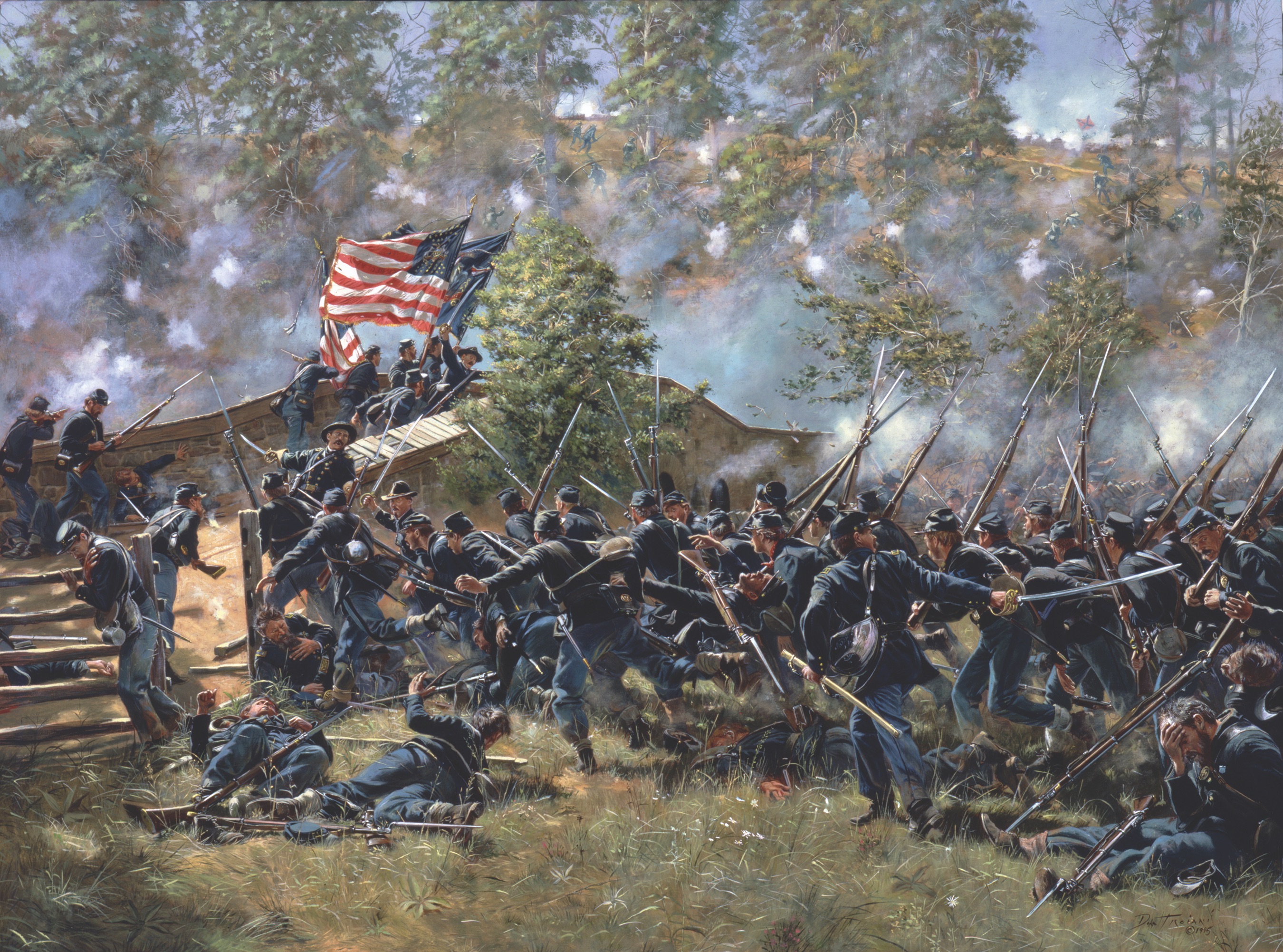
Numbers given in the two earliest postwar counts of Antietam’s dead quickly became the standard for generations of historians. Publication of the Official Records in 1887 provided for the first time a widely available, reliable source for such numbers, listing 2,108 Union dead at Antietam and 1,567 Confederates killed in the entire Maryland Campaign. Access to the Official Records enabled backstopping these totals and efforts to generate more detailed figures, which editors of The Century Illustrated Monthly magazine used in 1887 to publish a highly detailed—though still incomplete—list of each unit’s dead in its four-volume Battles and Leaders of the Civil War, reporting 2,108 Union and 1,512 Confederate deaths at Antietam.
As the century ended, two additional sources for Antietam’s dead and casualty numbers appeared. In 1900, Thomas L. Livermore published the first volume devoted solely to compiling figures from the war, Numbers and Losses in the Civil War in America, which used the Official Records’ 2,108 Union dead and revived McClellan’s October 1862 figure of 2,700 Confederate killed. Although Livermore’s volume quickly became influential, Antietam veteran and historian Brig. Gen. Ezra A. Carman’s 1894 work on Antietam, The Maryland Campaign (three volumes)—repeating the 2,108 Union dead figure but offering his own total of 1,546 Confederate killed—gained more lasting influence despite not being published until the late 1990s.
Recent Antietam histories draw from one or more of these sources. James V. Murfin’s 1965 The Gleam of Bayonets used McClellan’s September 1862 report and Guild’s numbers, offering 2,010 Union and 1,567 Confederate dead. Stephen Sears’ 1983 Landscape Turned Red, perhaps the best-known modern account of the battle, repeats Carman’s 2,108 Union and 1,546 Confederate dead. John M. Priest’s 1989 Antietam: The Soldiers’ Battle cites the Official Records and Battles and Leaders’ figures and methods to generate 2,157 Union and 1,754 Confederate killed. Joseph Harsh’s 2000 Taken at the Flood, examining Southern actions at Antietam, uses Carman’s 1,546 Confederate dead figure.
Regardless of which source historians used, since 1862 it has been accepted that slightly more than 2,000 Union and 1,500 Confederate soldiers died on September 17, 1862—a total of 3,500 lives.
Last May, the discovery of a new map upended 158 years of scholarship by offering insights unavailable to all these historians and documentarians. This occurred when Adams County Historical Society researchers Timothy Smith and Andrew Dalton uncovered an 1864 map in the New York Public Library that depicts in detail the burials of those who fell on America’s bloodiest day. It was created by Simon Green Elliott (1828-1897), who before the war worked as a railroad engineer in California. Upon returning east, Elliott had famously also mapped the Gettysburg battlefield’s burials, a resource housed today in the Library of Congress.
Walking the ground around Sharpsburg, which remained a massive cemetery in 1864, Elliott chronicled the location, Union or Confederate affiliation, and what appears to be a fairly exact number of graves, as reflected in the exacting, differing number of each burial plot. Elliott rediscovered the mass resting place of several regiments, both Union and Confederate, using temporary markers that Union burial details left for later reburial teams. He recorded inscriptions of handhewn grave markers and headstones bearing names of a few of the fallen, created in Antietam’s immediate aftermath by brothers and friends, like those that Ephraim Brown described.
The burial sites of fallen horses are also recorded along with the locations of artillery batteries—the latter probably reflecting remaining evidence of their presence or locals’ accounts, because by 1864 these guns were long gone to other battlefields. By 1866, with the opening of the Antietam National Cemetery and other such grounds, most of the burials that Elliott depicted had been moved elsewhere. Despite some minor errors in recording names and unit designations, his record offers us today a glimpse of a moment in time that is no more.
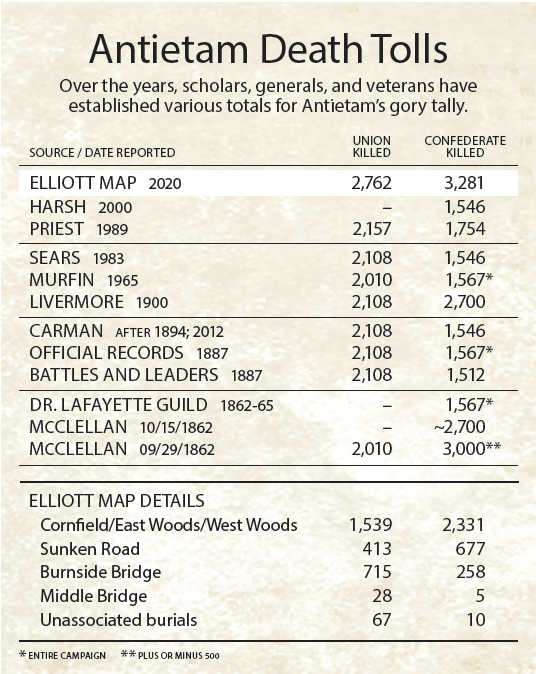 Simon Elliott’s work instantly placed him in the top ranks of those recording counts of Antietam’s dead. Ironically, even with his own unique creation available, Elliott’s map sidebar text repeats McClellan’s report figures, listing 2,010 Union and 3,500 Confederate dead, totaling 5,500 slain. He had missed a golden opportunity.
Simon Elliott’s work instantly placed him in the top ranks of those recording counts of Antietam’s dead. Ironically, even with his own unique creation available, Elliott’s map sidebar text repeats McClellan’s report figures, listing 2,010 Union and 3,500 Confederate dead, totaling 5,500 slain. He had missed a golden opportunity.
This is because a simple, if time-consuming, count of the burials captured on Elliott’s map reveals a more accurate picture of the number killed on America’s bloodiest day than has previously been available. It shows 2,762 Union dead buried on the battlefield, while a similar count of Confederate burials reveals 3,281 dead. Combining the two figures offers a total of 6,043 deaths on September 17, 1862.
These figures captured on the Elliott Map reveal the cost of America’s bloodiest single day to be considerably higher than previously understood, both in the aggregate and by sectional divisions. On the Union side, it shows 654 more dead than reported by the Official Records, the most widely used figure by historians for depicting the Federal cost.
Elliott’s revelations about Antietam’s Confederate dead are even more significant and startling, bearing twice the long-accepted number. Showing 1,714 more Southern fallen than the Official Records’ and Guild’s total for the entire campaign, 1,735 more than Carman’s Antietam figure, and 531 more than Livermore’s battle count suggests just how great was the Confederacy’s loss of manpower in this greatest struggle of Lee’s Maryland Campaign. A further irony of the map is that of all numbers given for Antietam’s Confederate dead it is George McClellan—regularly criticized for playing loose with numbers—who provided the figure closest to Elliott’s, only 219 more than shown on the 1864 map.
Elliott’s map also allows more accurate, detailed counts of the deaths caused by several actions that comprise the Battle of Antietam, offering new insight into the course and implications of those actions and the battle as a whole. The early morning fighting on the Union right/Confederate left flanks north of Sharpsburg (Miller’s Cornfield, the East Woods, and the West Woods) together generated 1,539 Union dead and 2,331 Confederate killed. That these and several nearby similarly intertwined actions resulted in more than half of the battle’s killed—3,870 of its 6,043 total—shows just how significant to the battle’s outcome was this morning round of fighting.
The cost of fighting in and around the famous “Bloody Lane” is reflected, too, on Elliott’s map, suggesting the scope and impact of this action. The 413 Union burials graphically show just how costly was this action, disconnected from Federal tactical planning, which kept two full divisions from contributing to McClellan’s larger battle objectives. Similarly, the 677 Confederate dead in the nearby fields suggest the high price the South paid for defending this position and the number of men unavailable when Lee unsuccessfully sought to take the offense late on September 17. The Sunken Road fight was a deadly, costly sideshow, indeed.
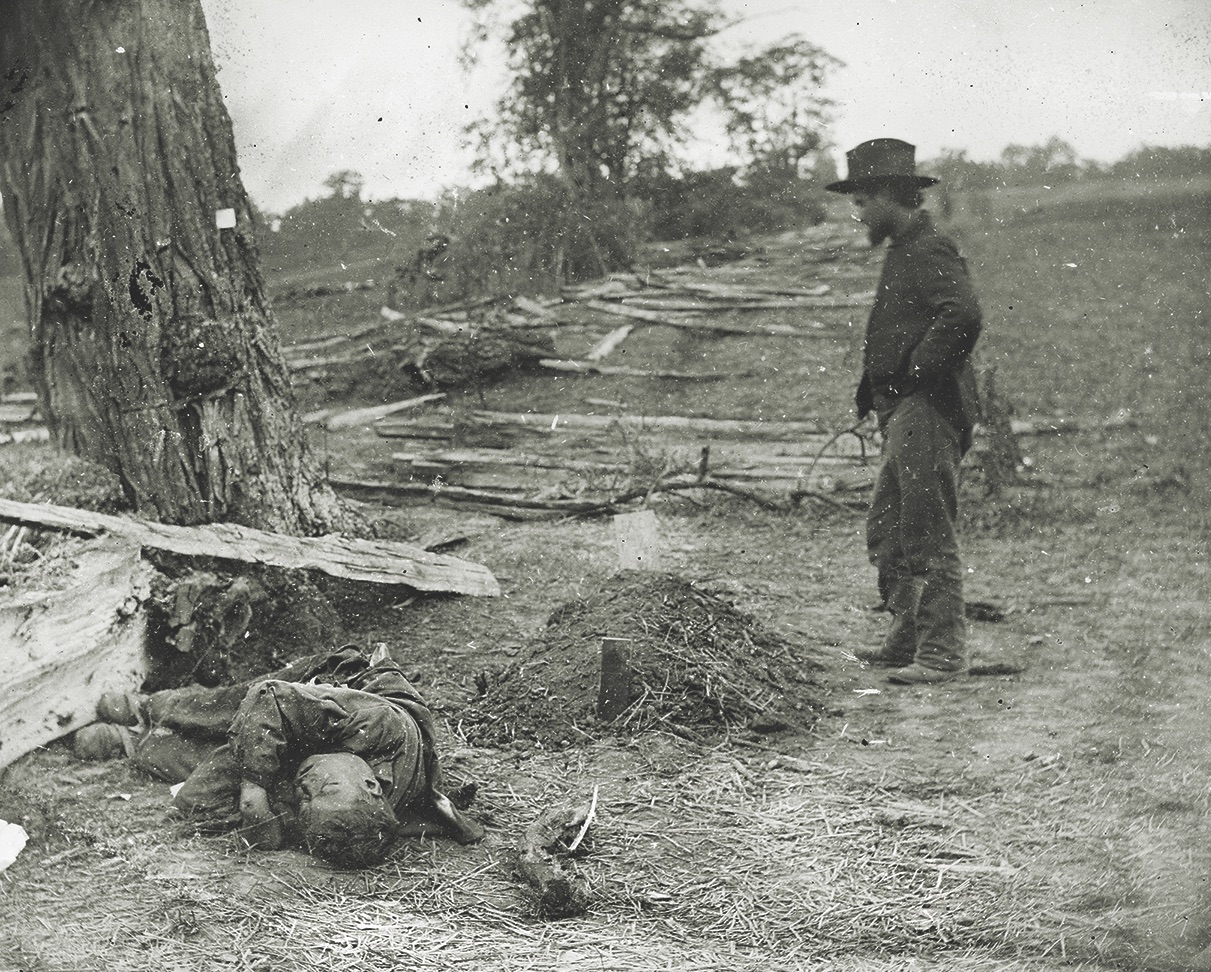
Losses depicted from the midday and late afternoon fighting south of Sharpsburg centered on the picturesque, famous “Burnside [Rohrbach] Bridge” are similarly revealing. The 715 Union burials there show how costly Maj. Gen. Ambrose Burnside’s uncertain efforts were to cross the bridge and attack the Confederate right flank, particularly when considered against the 258 Confederate lives spent in defending this spot. Further complicating capturing the full cost of this action is that a torn, missing portion on the right edge breaks the depiction of a line of Union graves, probably forever preventing their inclusion.
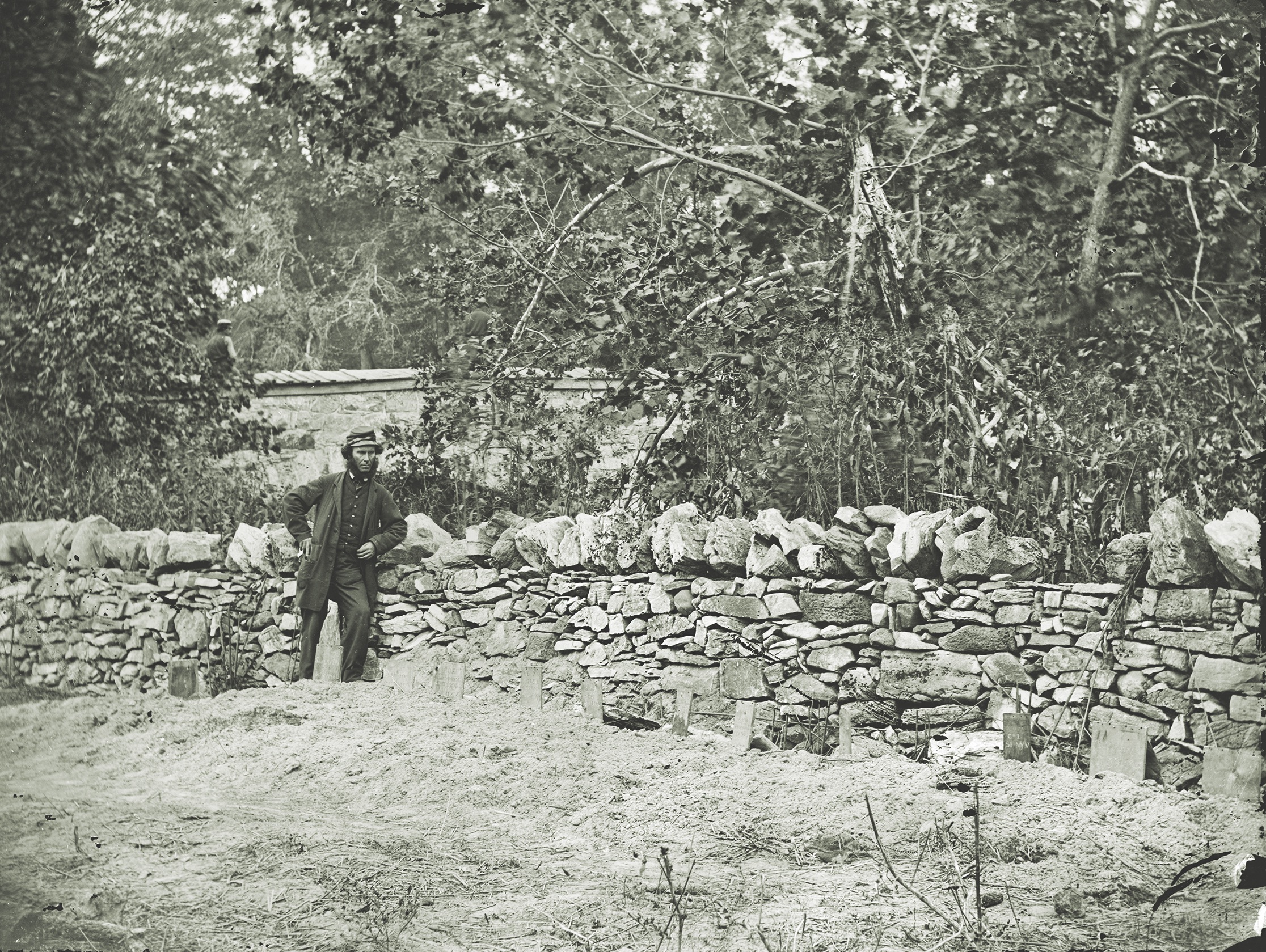
Even the small number of burials along the Middle Bridge and Boonsboro Pike reveal Antietam’s ultimate course. Planned by McClellan to be the location of his main, final push into Lee’s center—weakened by his moving troops to defend his flanks—the burial of only 28 Union and five Confederate dead here reflects an attack that never materialized, of what might have been had Antietam’s fight unfolded differently.
In a larger sense, to understand just how great the human cost of America’s bloodiest day was, consider that as horrific as is the sight of this massive burying ground and the numbers depicted on Elliott’s map, it still fails to account for all the dead of that day. Including only those killed on September 17, 1862, or shortly thereafter who died and were buried on the fields immediately surrounding Sharpsburg; it does not capture the fates of those among the 17,779 wounded—some 9,075 Union and 8,724 Confederate, according to the Official Records—who later died of their Antietam injuries. Those who died of these wounds at various hospitals—ranging from temporary field aid stations surrounding Sharpsburg for dozens of miles to large, modern hospitals in Philadelphia, Washington, and elsewhere—were buried nearby and so are largely not reflected on Elliott’s map or in most counts of Antietam deaths.
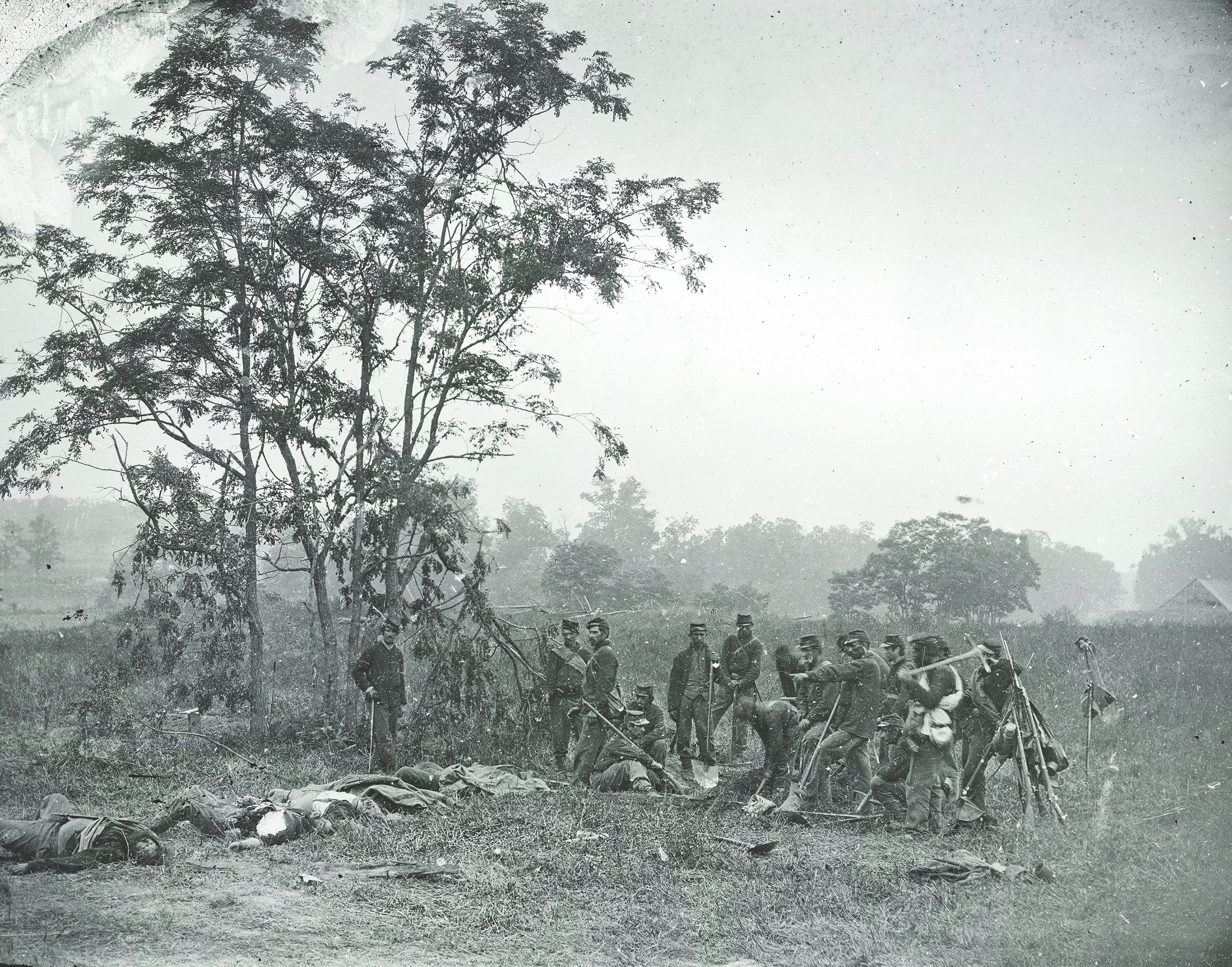
Private Henry Clark of the 88th Pennsylvania Infantry is just one of those almost certainly uncounted Antietam deaths. Wounded on September 17, probably during fighting in the East Woods, he survived in an Alexandria, Va., hospital until January 6, 1864. Clark’s cause of death was listed as “pleurisy”—inflammation of the lungs and chest—but he had never recovered from his Antietam wound, which likely caused this condition and his demise. Although Clark’s death was as surely caused by America’s bloodiest day as were those depicted on Elliott’s map, it remains unconnected to the battle by government records and so probably was not counted in any Antietam casualty figures.
The Elliott Map’s revelations also suggest that Antietam’s widely used 22,720-man casualty count should increase, too. Adding Elliott’s 6,043 recorded dead to the traditionally accepted 19,070 collective wounded and missing totals results in 25,113 Antietam casualties. Applying this same approach to the sectional totals similarly raises those figures to 13,062 Union and 12,051 Confederate casualties for September 17. As mind-numbing as these figures are, adding cases of overlooked casualties like Henry Clark shows that America’s bloodiest day was in truth more costly than we have long, if imperfectly, understood.
Even if such a true, full accounting of the number of Antietam’s dead remains impossible to compile, Simon Elliott’s priceless 1864 map nonetheless has given us a valuable new tool to better understand the devastating human cost demanded by America’s bloodiest day.
David A. Welker, a professional historian and military analyst for the federal government who writes from Centreville, Va., is the author of The Cornfield: Antietam’s Bloody Turning Point (Casemate Press, 2020).

